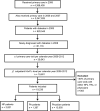Nurse Practitioners, Physician Assistants, and Physicians Are Comparable in Managing the First Five Years of Diabetes
- PMID: 28893514
- PMCID: PMC5817031
- DOI: 10.1016/j.amjmed.2017.08.026
Nurse Practitioners, Physician Assistants, and Physicians Are Comparable in Managing the First Five Years of Diabetes
Abstract
Background: Increasing use of nurse practitioners and physician assistants is a possible solution to the shortage of primary care providers in the United States, but the quality of care they provide is not well understood.
Methods: Because the scope of practice of the 3 provider types is similar in the Veterans Health Administration, we determined whether patients managed by primary care nurse practitioners, physician assistants, or physicians had similar hemoglobin A1c levels at comparable times in the natural history of diabetes. Our retrospective cohort study examined veterans with newly diagnosed diabetes in 2008, continuous primary care from 2008 to 2012, and more than 75% of primary care visits with nurse practitioner, physician assistant, or physician.
Results: Of the 19,238 patients, 95.3% were male, 77.7% were white, and they had a mean age 68.5 years; 14.7%, 7.1%, and 78.2% of patients were managed by nurse practitioners, physician assistants, and physicians, respectively. Median hemoglobin A1c was comparable at diagnosis (6.6%, 6.7%, 6.7%, P > .05) and after 4 years (all 6.5%, P > .5). Hemoglobin A1c levels at initiation of the first (7.5%-7.6%) and second (8.0%-8.2%) oral medications for patients of nurse practitioners and physician assistants compared with that of physicians was also similar after adjusting for patient characteristics (all P > .05). Nurse practitioners started insulin at a lower hemoglobin A1c (9.4%) than physicians (9.7%), which remained significant after adjustment (P < .05).
Conclusions: At diagnosis and during 4 years of follow-up, diabetes management by nurse practitioners and physician assistants was comparable to management by physicians. The Veterans Health Administration model for roles of nurse practitioners and physician assistants may be broadly useful to help meet the demand for primary care providers in the United States.
Keywords: Diabetes; Midlevel providers; Nurse practitioner; Physician assistant; Primary care.
Published by Elsevier Inc.
Conflict of interest statement
Other authors have no potential conflicts of interest to declare.
Figures



Comment in
-
Role of Paramedical Staff in a Health Service.Am J Med. 2018 Sep;131(9):e399. doi: 10.1016/j.amjmed.2018.02.028. Am J Med. 2018. PMID: 30266277 No abstract available.
Similar articles
-
Intermediate Diabetes Outcomes in Patients Managed by Physicians, Nurse Practitioners, or Physician Assistants: A Cohort Study.Ann Intern Med. 2018 Dec 18;169(12):825-835. doi: 10.7326/M17-1987. Epub 2018 Nov 20. Ann Intern Med. 2018. PMID: 30458506
-
Factors Associated With Having a Physician, Nurse Practitioner, or Physician Assistant as Primary Care Provider for Veterans With Diabetes Mellitus.Inquiry. 2017 Jan 1;54:46958017712762. doi: 10.1177/0046958017712762. Inquiry. 2017. PMID: 28617196 Free PMC article.
-
Comparative effectiveness of outpatient cardiovascular disease and diabetes care delivery between advanced practice providers and physician providers in primary care: Implications for care under the Affordable Care Act.Am Heart J. 2016 Nov;181:74-82. doi: 10.1016/j.ahj.2016.07.020. Epub 2016 Aug 28. Am Heart J. 2016. PMID: 27823696
-
Nurse practitioners and physician assistants in the intensive care unit: an evidence-based review.Crit Care Med. 2008 Oct;36(10):2888-97. doi: 10.1097/CCM.0b013e318186ba8c. Crit Care Med. 2008. PMID: 18766097 Review.
-
Specialized nursing practice for chronic disease management in the primary care setting: an evidence-based analysis.Ont Health Technol Assess Ser. 2013 Sep 1;13(10):1-66. eCollection 2013. Ont Health Technol Assess Ser. 2013. PMID: 24194798 Free PMC article. Review.
Cited by
-
Potentially inappropriate medication prescribing by nurse practitioners and physicians.J Am Geriatr Soc. 2021 Jul;69(7):1916-1924. doi: 10.1111/jgs.17120. Epub 2021 Mar 22. J Am Geriatr Soc. 2021. PMID: 33749843 Free PMC article.
-
Complexity as a factor for task allocation among general practitioners and nurse practitioners: a narrative review.BMC Fam Pract. 2020 Feb 17;21(1):38. doi: 10.1186/s12875-020-1089-2. BMC Fam Pract. 2020. PMID: 32066391 Free PMC article. Review.
-
Attitudes of medical doctors and nurses towards the role of the nurses in the primary care unit in Italy.Prim Health Care Res Dev. 2018 Jul;19(4):407-415. doi: 10.1017/S1463423617000846. Epub 2017 Dec 22. Prim Health Care Res Dev. 2018. PMID: 29268813 Free PMC article.
-
Effect of Remote Glucose Monitoring Utilizing Computerized Insulin Dose Adjustment Algorithms: A Pilot Project.Diabetes Ther. 2019 Apr;10(2):523-533. doi: 10.1007/s13300-019-0565-y. Epub 2019 Feb 5. Diabetes Ther. 2019. PMID: 30721451 Free PMC article.
-
Utilization and Costs by Primary Care Provider Type: Are There Differences Among Diabetic Patients of Physicians, Nurse Practitioners, and Physician Assistants?Med Care. 2020 Aug;58(8):681-688. doi: 10.1097/MLR.0000000000001326. Med Care. 2020. PMID: 32265355 Free PMC article.
References
-
- Centers for Disease Control and Prevention. National Diabetes Statistics Report: Estimates of diabetes and its burden in the United States. Atlanta, GA: 2014. 2014.
-
- Iglehart JK. Expanding the role of advanced nurse practitioners--risks and rewards. The New England journal of medicine. 2013;368:1935–41. - PubMed
-
- Physician Compensation and Production Survey 2012 Report Based on 2011 Data. Englewood, CO: Medical Group Management Association; 2012.
Publication types
MeSH terms
Substances
Grants and funding
LinkOut - more resources
Full Text Sources
Other Literature Sources
Medical

